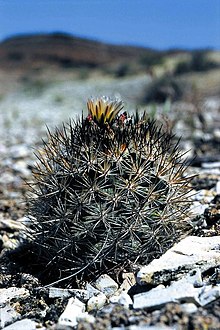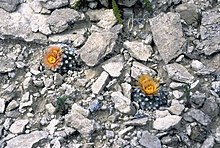Pediocactus
| Pediocactus | ||||||||||||
|---|---|---|---|---|---|---|---|---|---|---|---|---|

Pediocactus nigrispinus in Idaho |
||||||||||||
| Systematics | ||||||||||||
|
||||||||||||
| Scientific name | ||||||||||||
| Pediocactus | ||||||||||||
| Britton & Rose |
Pediocactus is a genus of plants from the subfamily Cactoideae in the cactus family(Cactaceae). Although some Pediocactus species are among the most common and common cacti in the southwest and northwest of the United States , some extremely rare species have been included in Appendix 1 of the Washington Convention on Endangered Species. All Pediocactus species are considered frost hardy .
description
The species of the genus Pediocactus grow small, single or sprout and reach heights of up to 20 centimeters. The green to glaucous shoots are cylindrical to spherical or depressed spherical. They reach a diameter of 1 to 15 centimeters and heights of 0.7 to 20 centimeters. There are no ribs , but warts 2 to 12 millimeters long and 2 to 11 millimeters in diameter. The areoles have a diameter of 1 to 6 millimeters. They are usually 1 to 6 millimeters (rarely up to 12 millimeters) apart. The thorns , which mostly cover the shoots , differ in their number, color and position. The up to ten light gray or white central spines, which can also be missing, are spread out, straight or curved, needle-like, bristle-like or corky. They are 0.5 to 3.2 inches long. The three to 35 radial spines are reddish to whitish, spread out, straight or curved. In some species they are placed in a comb shape. The radial spines reach a length of 0.1 to 2.1 centimeters.
The color of the bell-shaped flowers appearing at the apex of the shoots varies from yellow to magenta to white. The flowers are 1 to 2.5 centimeters in diameter. Your pericarpel and the short tube are bare or almost bare. The flowering time is in spring. Some species form flower buds as early as late autumn. Some species are able to flower in the juvenile stage.
The cylindrical to spherical fruits are initially greenish. When ripe , they turn reddish-brown and dry. The fruits are bare or have a few scales. They tear open with a vertical column. The remnants of the flowers only partially fall off the fruits. It leaves a residue that appears as a lid when the fruit is opened. The fruits contain blackish brown, wrinkled to tubercular, obovate or pear-shaped seeds . The seeds are ripe 4 to 6 weeks after flowering. They remain viable for an exceptionally long time (at least 10 years).
distribution
The natural distribution of the genus Pediocactus extends over the US states of Arizona , Colorado , Idaho , Nevada , New Mexico , Oregon , Montana , Utah , Washington and Wyoming ; Deposits are found on the Colorado Plateau , in the Rocky Mountains , the Great Plains , in the Great Basin Desert , in the Columbia River Basin, and on the Columbia Plateau. Climate and soil conditions vary greatly across the entire range. The lowest occurrences are known from Pediocactus nigrispinus in Washington at an altitude of 260 meters, whereas Pediocactus simpsonii in Colorado at altitudes 3200 meters rises.
The desert-like conditions of the high plateaus (winter periods down to minus 30 ° C, summer periods up to 45 ° C) apparently offer ideal conditions. The average annual precipitation is 250 to 500 mm.
Systematics

The first description by Nathaniel Lord Britton and Joseph Nelson Rose was published in 1913. The type species of the genus is Echinocactus simpsonii .
There are different views on the scope and taxonomic structure of the genus.
- Anderson (2005)
Edward Frederick Anderson accepted the following species and varieties in 2005:
- Pediocactus bradyi L.D.Benson
- Pediocactus despainii S.L.Welsh & Goodrich
- Pediocactus hermannii W.T. Marshall
- Pediocactus knowltonii L.D.Benson
- Pediocactus paradinei B.W.Benson
- Pediocactus peeblesianus (Croizat) LDBenson
-
Pediocactus simpsonii (Engelm.) Britton & Rose
- Pediocactus simpsonii var. Minor (Engelm.) LDBenson
- Pediocactus simpsonii var. Robustior (JMCoult.) LDBenson
- Pediocactus simpsonii var. Simpsonii
- Pediocactus winkleri K.D. Heil
- Hunt (2006)
David Richard Hunt recognized the following species and subspecies in his 2006 New Cactus Lexicon :
-
Pediocactus bradyi L.D.Benson
- Pediocactus bradyi subsp. bradyi
- Pediocactus bradyi subsp. despainii (SLWelsh & Goodrich) Hochstätter
- Pediocactus bradyi subsp. winkleri (KDHeil) Hochstätter
- Pediocactus knowltonii L.D.Benson
- Pediocactus nigrispinus (Hochstätter) Hochstätter
- Pediocactus paradinei B.W.Benson
-
Pediocactus peeblesianus (Croizat) LDBenson
- Pediocactus peeblesianus subsp. fickeiseniorum (Hochstätter) Lüthy
- Pediocactus peeblesianus subsp. peeblesianus
- Pediocactus sileri (Engelm.) LDBenson
- Pediocactus simpsonii (Engelm.) Britton & Rose
- Hochstätter (2007)
Fritz Hochstätter , who studied the genus in its natural habitat, made the following subdivision in his 2007 monograph:
- Section Pediocactus Hochstätter
- Pediocactus knowltonii L.D.Benson
-
Pediocactus nigrispinus (Hochstätter) Hochstätter
- Pediocactus nigrispinus subsp. nigrispinus
- Pediocactus nigrispinus subsp. beastonii (Hochstätter) Hochstätter
- Pediocactus nigrispinus subsp. indranus (Hochstätter) Hochstätter
- Pediocactus paradinei B.W.Benson
-
Pediocactus simpsonii (Engelm.) Britton & Rose
- Pediocactus simpsonii subsp. simpsonii
- Pediocactus simpsonii subsp. bensonii Hochstätter
- Pediocactus simpsonii subsp. idahoensis Hochstätter
- Pediocactus simpsonii subsp. robustior (JMCoult.) Hochstätter
- Section Rhytidospermae Hochstätter
-
Pediocactus bradyi L.D.Benson
- Pediocactus bradyi subsp. bradyi
- Pediocactus bradyi subsp. despainii (SLWelsh & Goodrich) Hochstätter
- Pediocactus bradyi subsp. winkleri (KDHeil) Hochstätter
- Pediocactus sileri (Engelm.) LDBenson
-
Pediocactus bradyi L.D.Benson
where he understood Pediocactus peeblesianus as the only species of the genus Navajoa .
Synonyms of the genus are Utahia Britton & Rose , Navajoa Croizat , Pilocanthus B.W.Benson & Backeb. , Neonavajoa Doweld and Puebloa Doweld
Danger
The species Pediocactus sileri , Pediocactus bradyi , Pediocactus paradinei and Pediocactus knowltonii are listed in Appendix 1 of the Washington Convention on Endangered Species . Pediocactus nigrispinus is classified as extremely endangered. Since almost all representatives of the genus (with the exception of Pediocactus simpsonii and subspecies) are extremely endangered, it would be conceivable to include the entire genus in Appendix 1, analogous to the procedure for comparable genera.
literature
- Edward F. Anderson : The Great Cactus Lexicon . Eugen Ulmer KG, Stuttgart 2005, ISBN 3-8001-4573-1 , p. 517-520 .
- Lyman D. Benson: The Cacti of the United States and Canada . Stanford University Press, Pasadena (CA) 1982.
- Nathaniel Lord Britton, Addison Brown: An illustrated flora of the northern United States, Canada and the British possessions: from Newfoundland to the parallel of the southern boundary of Virginia, and from the Atlantic Ocean westward to the 102d meridian . Volume 2, 1913, p. 569 (online) .
- David Hunt : The New Cactus Lexicon . dh books, Milborne Port 2006, ISBN 0-9538134-4-4 , pp. 225-226 .
- Ken D. Heil, Barry Armstrong, David Schleser: A review of the genus Pediocactus . In: Cactus and Succulent Journal . Volume 53, 1981, pp. 17-39.
- Fritz Hochstätter: The Genera Pediocactus, Navajoa, Toumeya . Self-published, 2007, ISBN 978-3-00-021244-4 .
- Fritz Hochstätter: The genus Pediocactus A review and annotated checklist of all known pediocacti . In: Cactus World . Volume 26, Number 3, 2008, pp. 141-150.
- Adolf Mühl: The Genus Pediocactus . In: Cactaceae Review . 1998-2007.
Individual evidence
- ^ A b c Edward F. Anderson : The great cactus lexicon . Eugen Ulmer KG, Stuttgart 2005, ISBN 3-8001-4573-1 , p. 517 .
- ^ A b Fritz Hochstätter : The Genera Pediocactus, Navajoa, Toumeya . Self-published, 2007, ISBN 978-3-00-021244-4 , p. 10.
- ^ Nathaniel Lord Britton, Addison Brown: An illustrated flora of the northern United States, Canada and the British possessions. From Newfoundland to the parallel of the southern boundary of Virginia, and from the Atlantic Ocean westward to the 102nd meridian . 2nd Edition. Volume 2, 1913, p. 569 ( online ).



